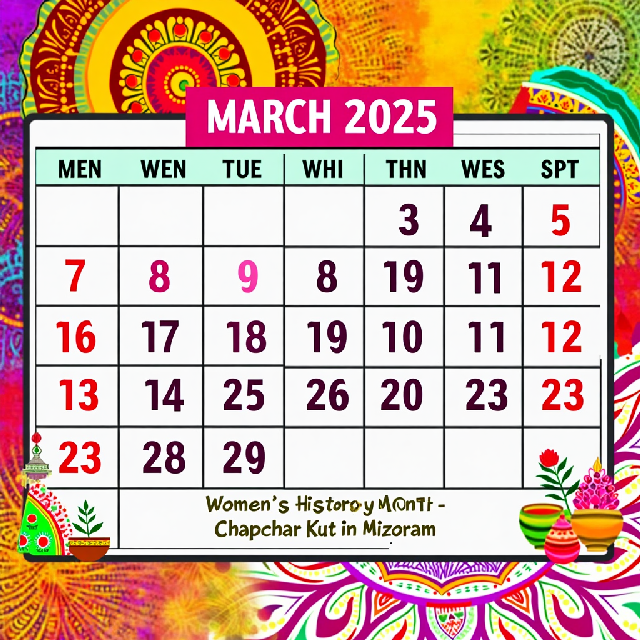Introduction to March 2025 Calendars: Why They Matter for Planning and Organization
March 2025 may seem distant, but effective planning begins early. Whether organizing events, tracking holidays, or managing personal schedules, a reliable calendar is indispensable. March 2025 calendars are strategic tools that offer more than just date-keeping—they help you stay ahead.
Why March 2025 Calendars Are Important
-
Event Planning Made Easy
These calendars highlight key dates like holidays and cultural events, essential for planning conferences or personal gatherings. Tools like Google Calendar and specialized planners aid team coordination and avoid scheduling conflicts. -
Organizing Holidays and Celebrations
March 2025 features regional and cultural holidays worldwide, such as India’s Holi, the U.S.’s Women’s History Month, and Mizoram’s Chapchar Kut. Calendars ensure you don’t miss these significant dates. -
Personal Organization at Its Best
A well-structured calendar enhances time management, deadline reminders, and work-life balance. Digital tools offer syncing across devices, while physical planners provide a tactile approach to organization.
Regional Holiday Differences
March 2025 calendars highlight regional variations:
- India: Celebrate Holi on March 18, a vibrant festival symbolizing victory over evil.
- U.S. and Canada: Honor Women’s History Month, celebrating women’s contributions.
- Mizoram, India: Observe Chapchar Kut, a harvest festival reflecting local culture.
These differences underscore the need for location-specific calendars.
Digital vs. Physical: Which is Better?
The debate continues:
Digital Calendars
- Pros: Accessibility across devices, reminders, collaboration features, and customization.
- Cons: Distractions from notifications, tech dependency, potential overload.
Popular Platforms: Google Calendar for seamless integration, Microsoft Outlook for professionals, and Calendly for appointment scheduling.
Physical Calendars
- Pros: Tactile experience aiding memory retention, distraction-free use, and visual appeal.
- Cons: Space constraints, limited sharing, less flexibility.
Popular Options: Canva templates for customization, Etsy planners for unique designs.
Key Features to Look For
- Customizable Templates: Tailor your calendar with digital tools or printable PDFs.
- Regional Holiday Markings: Ensure relevance to cultural context.
- Digital Integrations: Enhance collaboration with features like Google Calendar sharing.
Final Thoughts
March 2025 calendars are roadmaps for success, aiding global campaigns, local events, and personal tasks. Choose a calendar that fits your style—digital, physical, or a mix—and start planning now!
Download your free March 2025 printable calendar or explore digital options like Google Calendar.
#March2025 #CalendarPlanning #EventOrganization #ProductivityHacks
Cultural Significance of Holidays in Hong Kong and the U.S.
Understanding regional holidays fosters cross-cultural appreciation:
Hong Kong
- Birthday of the Buddha (May 5): A time for meditation and family gatherings.
- Tuen Ng Festival (May 31): Features dragon boat races and zongzi consumption.
U.S.
- Easter Monday (April 21): Celebrates renewal with family gatherings.
- Memorial Day (May 26): Honors military service with remembrance ceremonies.
These holidays reflect cultural identities, blending tradition with modern celebrations.
Impact on Scheduling
Regional holidays influence planning:
- Hong Kong: Increased statutory holidays emphasize work-life balance but challenge businesses to maintain productivity.
- U.S.: Holidays like Memorial Day affect travel and retail, prompting operational adjustments.
Organizations must adapt to these differences for smooth operations.
Conclusion
March 2025 highlights unique cultural landscapes through its holidays. Understanding these fosters global collaboration and strategic planning. Whether for reflection or business, these holidays offer opportunities for growth.
#HolidayTraditions #CulturalDiversity #HongKong #USA #WorkLifeBalance
Sources for Quick Printing of March 2025 Calendars
Find reliable websites for quick printing:
Top Picks
- Printabulls: 107 free templates with various designs.
- Wiki-Calendar: Customizable blank calendars with U.S. holidays.
Customization Options
- General Blue: Editable templates in PDF, Word, or Excel.
- Canva: Create unique designs for printable or digital use.
Holiday Markings
- Calendar Quickly: Includes St. Patrick’s Day and Pi Day.
- Natasha LH: Features World Wildlife Day and Spring Equinox.
Design Variety
- First Printable: 40+ stylish PDF calendars.
- World of Printables: Over 130 designs from minimalist to vibrant.
Print your March 2025 calendar today and stay organized!
#March2025 #CalendarPrinting #OrganizationTools
Ensuring Accuracy of Holiday Information
Accurate holiday data is crucial for seamless planning:
Why Verify Dates?
- Avoid scheduling conflicts and cultural insensitivity.
- Prevent operational disruptions in business.
Regional Variations
Holidays vary globally, such as Diwali in India vs. Thanksgiving in the U.S. and Canada.
Cross-Checking Tips
- Use official sources like government websites.
- Leverage tools like Google Calendar for real-time data.
- Engage with communities for local insights.
Best Practices
- Plan ahead, communicate clearly, and stay flexible to adapt to changes.
Ensure accuracy to foster inclusivity and avoid conflicts in global collaborations.
#HolidayAccuracy #GlobalPlanning #CulturalSensitivity

I’m curious how the author handles differences between digital and physical calendars, especially whether events marked digitally transfer accurately to printed versions, given the focus on regional holidays.
How does the article handle challenges when syncing digital and physical calendars? Especially with different regional holidays—does it offer a way to ensure accurate transfers?
The article discusses the pros and cons of digital and physical calendars but misses key details about syncing them or handling regional holidays across formats. While it mentions tools like Google Calendar and Canva, it doesn’t offer guidance on transferring holiday dates accurately between platforms. This leaves readers without clear advice on keeping their planners consistent—a crucial part of effective planning.
I’m curious how the author manages the shift from digital to physical calendars, particularly whether digital events translate accurately into printed versions, considering their emphasis on local holidays.